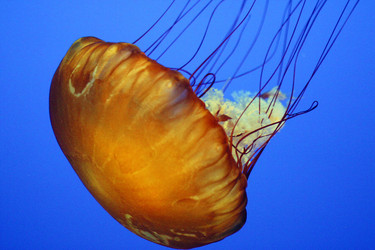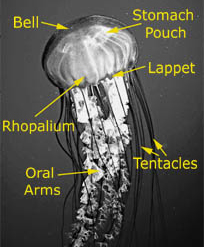The Jellyfish


GNU Free documentation license by Tom Murphy
Kingdom: Animalia
- Phylum: Cnidaria
- Class: Scyphozoa
- Order: Acalephae
- Family: Semosromidas
- Genus: Varies among types of jellyfish
- Species: Varies among types of jellyfish
Development

http://en.wikipedia.org/wiki/Jellyfish Originally came from the U.S. National Oceanic and Atmospheric Administration
The jellyfish passes through two different body forms through its lifetime. The medusa is the more commonly known form, while the polyp is restricted to the larval stage. Larvae, also known as planula exit through the mouth or brood pouches of the female and enter the water. These larvae begin forming polyps after they attach themselves to the bottom of a shaded area. These polyps divide and bud into young jellyfish (ephyra). Several weeks later an ephyra will grow into an adult medusa. An adult will normally live three to six months [1]


GNU free documentation license wikipedia
A jellyfish has no coelom and has radial symmetry. They have an incomplete digestive system, meaning that they use the same orifice for food intake and expelling waste. They are composed of epidermis, gasrodermis, and a thick jellylike layer called mesoglea that separates the first two layers [1]. Jellyfish don’t have a brain, heart, bones, or eyes [3]. Nor do they have a respiratory system since their thin skin easily diffuses oxygen in and out of their bodies. Jellyfish have limited control over their movement and mostly free-float, but can use a hydrostatic skeleton that controls the water pouch in their body to actuate vertical movement. They are composed of over 95% water. Their reproductive organs develop in the lining of the gut. During reproduction, the male releases sperm through its mouth into the water where they swim into the mouth of the female and fertilization occurs. To compensate for its lack of basic sensory organs and a brain the jellyfish exploits its nervous system to perceive stimuli, such as light or odor, and orchestrate responses. A nerve net, which is found in its epidermis, helps jellyfish detect the touch of other animals. Impulses to the nerve cells are sent from nerve rings that have collected information from the environment of the jellyfish through the rhopalial lappet, which is located around the animal’s body.
Characteristics
Jellyfish come in different sizes, shapes and colors. Most jellyfish are opaque or glossy and bell shaped. The size of jellyfish depends on the type and ranges from very small to more than seven feet. Their tentacles can grow to more than 100 feet long. Most jellyfish are passive drifters that feed on small fish and zooplankton that become caught in their tentacles. They are carnivores.
Habitat
Many jellyfish live in oceans around the world and are capable of withstanding a large flux of temperature and salinities but are most commonly found in warm, shallow coastal waters. However, some live in depths of over 12,000 feet. Jellyfish do have symbiotic relationships. For example, some fish are immune to the sting of a jellyfish, so they can take shelter among the jellyfish’s tentacles, thereby baiting trap for other fish. In return, the fish get to share the meal with the jellyfish. In its juvenile stage the spider crab can be seen inside the bell of the jellyfish. They are passive drifters that feed on passing small fish and zooplankton that become caught in their tentacles. Although primarily drifters, jellyfish are predators. They are able to stun and kill their prey with stinging cells called nematocysts. When triggered by touch or movement they release toxins into the prey. The potency of this toxin varies among jellyfish. Normally their prey consists of microscopic animals, fish larvae and other jellyfish.
The Jellyfish Tale
Ideas about the following evolutionary tale on Jellyfish were adapted from The Ancestor’s Tale by Richard Dawkins. During World War II, sonar operators looking for submarines were bewildered with what they saw going on with the surface of the water. They seemed to think there was a false bottom of the sea that rose towards the surface as the sun disappeared and sank back down by the time the sun came up. Actually, it turned out to be millions of microorganisms including plankton and crustaceans. These little creatures come up to the surface at night when it’s dark to avoid predators that could see them in the daylight. The surface is where food that comes from the sun, by means of plants is abundant. The jellyfish migrate along with these herds of grazers, looking for a little midnight snack themselves [2]
Jellyfish Lake is one of the Palau Islands. This lake inhabits an estimated 20 million jellyfish in a relatively small lake. These jellyfish travel to the west side of the lake after dark. When the sun rises in the east, they all wander towards the eastern side. However, on their way towards the rising sun, they pause because the trees dark shadows reduce much of the sun’s light, that they begin to return to the sunnier western side. Once, they get through the dark shadows of the trees, they resume their journey to the eastern side of the lake. This keeps the jellyfish safe from the predatory sea anemones that line the shoreline. Mid-day the jellyfish chase the sun back to the western side. Where again they pause in the tree shadows. When the sun disappears, they swim vertically up and down at the western end, until the sun rises and their day repeats.
Something to think about
Jellyfish have long tentacles that bear nematocysts that sting and capture zooplankton and other small marine animals. These nematocysts are small, stinging, whip like structures that are discharged from the cells in response to outside chemical or mechanical stimuli or direct nerve stimulus. It consists of a capsule containing a coiled tube. When triggered, the capsule changes its water permeability and the inrush of water causes the tube to evert explosively ejecting the nematocyst from the cell. Since they are not reused following discharge and it is energetically costly to produce them, it's to the advantage of the jelly to fire only when necessary. Nematocysts inject chemical agents into their prey or human victim. Different species of jellies do, however, vary greatly in the toxins they inject. Those that specialize in preying on fish, such as the sea wasp or the Portuguese man-of-war, will tend to have very potent toxins that quickly immobilize the prey. Jellies that favor more gelatinous fare, like the egg-yolk jelly, don't need to concentrate on subduing the prey. Instead they often have nematocysts that are quite sticky and good at holding slimy blobs. Others like the moon jelly rely more on bell mucus to capture zooplankton. Stinging nematocysts function primarily for the capture of prey, and secondarily as a defense mechanism [4]. Knowing how jellyfish have these specialized cells that sting their prey and their predators, what special adaptations can you think of that other animals possess that are detrimental to their survival? What are they and how do they work?



 Go to quick links
Go to quick search
Go to navigation for this section of the ToL site
Go to detailed links for the ToL site
Go to quick links
Go to quick search
Go to navigation for this section of the ToL site
Go to detailed links for the ToL site